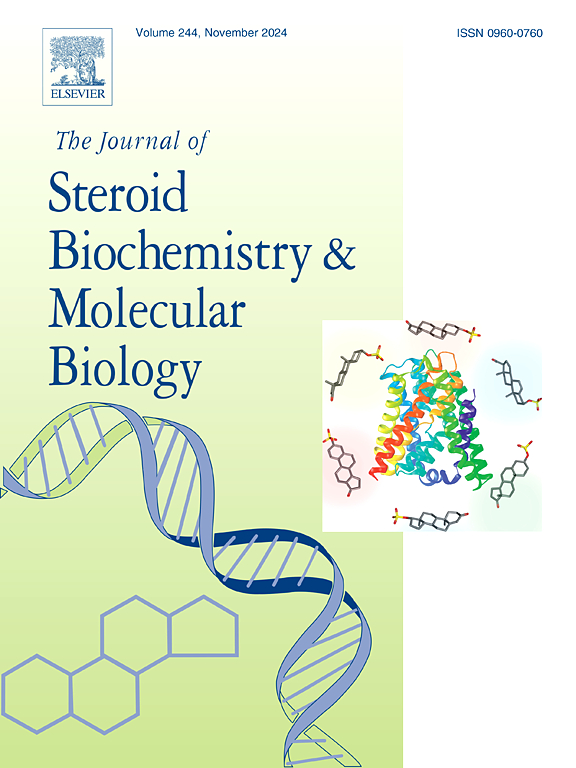红花叶甲醇提取物的抗雄激素和抗增殖作用。成年小鼠睾丸:来自体内和计算机研究的证据。
IF 2.5
2区 生物学
Q3 BIOCHEMISTRY & MOLECULAR BIOLOGY
Journal of Steroid Biochemistry and Molecular Biology
Pub Date : 2025-06-06
DOI:10.1016/j.jsbmb.2025.106798
引用次数: 0
摘要
雄激素分泌失调导致多种临床疾病,如男性型秃发、多毛症、寻常性痤疮、良性前列腺增生、前列腺癌和多囊卵巢综合征。虽然用于治疗这些疾病的常见合成药物有许多副作用,但对替代疗法和草药疗法的需求日益增长。Allamanda cathartica Linn。(家族,罗布麻科)传统上用于治疗各种疾病,因为它的保护肝脏,抗糖尿病,抗炎,抗肿瘤和抗菌特性。然而,Allamanda叶对睾酮产生的影响仍然难以捉摸。本研究旨在阐明毛细叶甲醇提取物(MLEAC)对成年小鼠睾丸雄激素生物合成和生殖细胞增殖的影响及其可能的作用机制。成年雄性C57BL/6J小鼠分别口服MLEAC(150和300mg/kg体重/天)或蒸馏水(对照组)42 d。MLEAC治疗引起睾丸组织结构不均匀的退行性改变。治疗还通过下调主要类固醇蛋白(StAR、CYP11A1、3β和17β-HSD3)的表达,对血清睾酮水平产生负面影响。流式细胞术和免疫组织化学分析显示mleac处理小鼠睾丸中gem细胞增殖受损。GC-MS法鉴定出MLEAC中20种植物化合物。硅研究进一步揭示了gc - ms衍生的植物化学物质有可能与睾丸中主要的类固醇蛋白结合。因此,MLEAC治疗通过下调睾酮产生抑制生殖细胞增殖。考虑到Allamanda的传统用途,目前的发现可能有助于寻找一种基于植物的抗雄激素化合物。本文章由计算机程序翻译,如有差异,请以英文原文为准。
Anti-androgenic and anti-proliferative properties of methanolic leaf extract of Allamanda cathartica Linn. in adult mouse testis: Evidences from in vivo and in silico studies
Dysregulation in androgen production causes a variety of clinical disorders like male pattern baldness, hirsutism, acne vulgaris, benign prostatic hyperplasia, prostate cancer and polycystic ovarian syndrome. Although the common synthetic drugs used to treat these diseases have many side effects, there is growing demand for alternative and herbal therapies. Allamanda cathartica Linn. (family, Apocynaceae) is traditionally used to treat variety of diseases because of its hepatoprotective, antidiabetic, anti-inflammatory, antitumor and antimicrobial properties. However, the effects of Allamanda leaves on testosterone production still remain elusive. The present study aims to elucidate the effect and possible mode(s) of action of the methanolic leaf extract of A. cathartica (MLEAC) on androgen biosynthesis and germ cell proliferation in adult mouse testis. Adult male C57BL/6J mice were orally administered MLEAC (150 and 300 mg/kg body weight/day) or distilled water (controls) for 42 days. MLEAC treatment caused non-uniform degenerative changes in the histoarchitecture of testis. The treatment also had negative impact on serum testosterone level with downregulation of the expressions of major steroidogenic proteins (StAR, CYP11A1, 3β-and 17β-HSD3). Flow cytometry and immunohistochemical analyses showed impaired gem cell proliferation in MLEAC-treated mice testes. The GC-MS method identified 20 phytocompounds in MLEAC. The in silico study further revealed that GC-MS-derived phytochemicals have the potential to bind with major steroidogenic proteins in testis. MLEAC treatment thus causes suppression of germ cell proliferation via downregulation of testosterone production. Keeping in view the traditional use of Allamanda, the present findings may prove helpful in the search of a plant-based anti-androgenic compound.
求助全文
通过发布文献求助,成功后即可免费获取论文全文。
去求助
来源期刊
CiteScore
8.60
自引率
2.40%
发文量
113
审稿时长
46 days
期刊介绍:
The Journal of Steroid Biochemistry and Molecular Biology is devoted to new experimental and theoretical developments in areas related to steroids including vitamin D, lipids and their metabolomics. The Journal publishes a variety of contributions, including original articles, general and focused reviews, and rapid communications (brief articles of particular interest and clear novelty). Selected cutting-edge topics will be addressed in Special Issues managed by Guest Editors. Special Issues will contain both commissioned reviews and original research papers to provide comprehensive coverage of specific topics, and all submissions will undergo rigorous peer-review prior to publication.

 求助内容:
求助内容: 应助结果提醒方式:
应助结果提醒方式:


